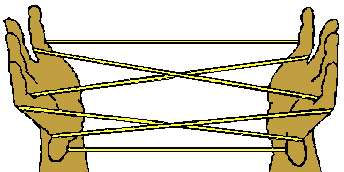
Some openings, endings (or extensions), and special moves preformed while making a figure are common to more than one figure. These are given their own names. Those not described have not yet been used by any figures in this collection.
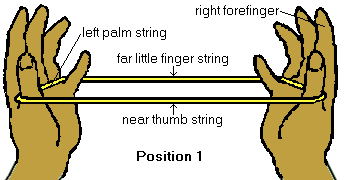
Position 1
(P1)
1 T pu SN:ex
2 L pu fTS:ex
Pick up one section of the string loop on both thumbs and extend hands apart. The string now goes from one thumb to the next without any twists in it. The string closest to you is called the near thumb string, and the farthest one is called the far thumb string. Now, using your little fingers, pick up the far thumb strings on the fingernail side of the little fingers. (If told to grab a string, you would curl your finger around it and either hold it with the fingerprint side or, if instructed to, twist it 180 degrees towards or away from you as directed to take the string up on the finger or thumb.) Now just spread your hands and fingers apart to tighten the string and you have Position 1. View video: Slow dial-up, Dial-up, Broadband

Opening A
(OA)
1 P1
2 rF ml-pu lPS
3 lF mr-th rFN pu rPS
Do Position 1. With your right forefinger, move left and pick up the left palm string on the back of the forefinger. The left forefinger then moves right, through the right forefinger noose, and picks up the right palm string.
View video: Slow dial-up, Dial-up, Broadband
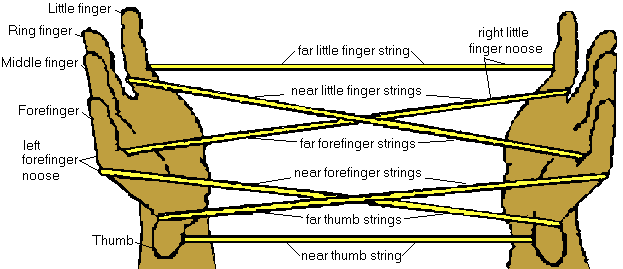
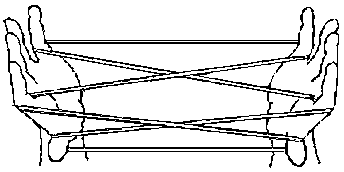
Opening B
(OB)
1 P1
2 lF mr-pu rPS
3 rF ml-th lFN pu lPS
Do Position 1. Use your left forefinger to move right and pick up the right palm string on the back of the forefinger. The right forefinger then moves left, through the left forefinger noose, and picks up the left palm string.
View video: Slow dial-up, Dial-up, Broadband
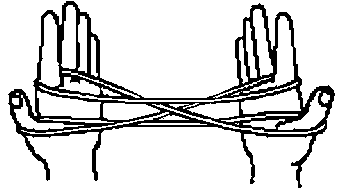
Navaho Opening
(NO)
1 F pu SN, P md, F together
2 lT gr rfFS:rT gr lfFS
3 T tw up, ex
This opening involves picking up the string loop on the forefingers. The forefingers are held close together, pointing away from you, and with palms down. The string hangs over the forefingers and between forefingers and middle fingers. The left thumb then grabs the right far forefinger string that is hanging down and pulls it just a little to the left. The right thumb can now grab the left far hanging forefinger string. Rotate thumbs up to pick up the hanging string, and extend hands apart.
View video: Slow dial-up, Dial-up, Broadband
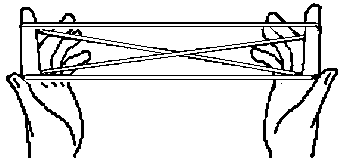
Index Opening
(IO)
1 TF gr SN:P md, H together
2 lTF ht rTFS:re rTF
3 rF mt-th N, F pu N, ex
Start this opening by grabbing a short 4 to 6 inch section of the string noose between thumbs and forefingers with palms down. (2) Next bring the thumbs and forefingers of each hand together and place the string held by the right thumb/forefinger next to, from the near side, the string held by the left thumb and forefinger. Hold on to this string, which now forms a loop, with your left thumb and forefinger, releasing the right thumb and forefinger. (3) Insert your right forefinger into the loop from the far side (the same way the left forefinger already is), then twist forefingers up towards you, and so take up the two nooses onto the forefingers. Extend your hands apart keeping the two nooses separate. This is also known as the Murray Island Opening.
Opening C (OC)
Wrist-Loop Opening (WLO)
Opening X (OX)
Mouth-Loop Opening (MLO)
Nauru Opening I
Nauru Opening II
Moves
Pick up (pu)
This means to pick up a string on the back or fingernail side of your finger or thumb (sometimes you may need to pick up a palm string using your entire hand or wrist).
Grab or Grasp (gr)
This means to bend or curl your finger or thumb around a string and hold it in the crook of the finger. This move is often followed by a twist to return the finger to its normal upright position. You may be told, then, to either twist your finger away from you and up to pick up the far string, or twist it toward you to pick up the near string (which then become the far string on that finger)
Transfer (tr)
This is similar to the idea of picking up, but involves the entire string noose and not just one near or far string. Transferring forefinger nooses to the thumbs would be the same as the thumbs picking up the forefinger nooses, removing them from the forefingers. Transferring implies removing a noose and putting it on another digit or even on to the hand or wrist. Sometimes you will need to transfer a noose from a digit on the right hand to one on the left, and then vice versa from the left to the right. You might also be asked to pick up a string on one finger and transfer it to your mouth. How you accomplish a transfer will vary, and is a matter of personal technique that you will develop.
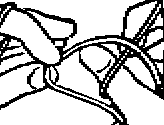
This is a commonly encountered move. When you pick up a string with a finger (or thumb) there may already be one or more strings on it. To navaho the finger means to remove the bottom or lowest string that was already there while leaving the other string(s) in place. Removing the lower of two strings from the thumbs can sometimes be done using your mouth to lift the near string up and over the thumbs. But a more elegant way is the use your middle fingers to go over the top strings to pick up and lift the lower string noose up and off the thumbs.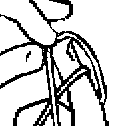
Otherwise you can simply lift the lower string off using the opposite hand. Use your right hand to reach over and remove the lower noose from the left hand, then use your left hand to do the same for the right hand. Navahoing the little fingers can usually be done by bending them down and letting the original string slip off.
Extend (ex)
After most moves, unless told the keep the strings loose, return hands and fingers to their normal position, and tighten the strings. The normal position would be with palms facing each other, parallel, and fingers up, spread apart, with thumbs pointed towards you.
Arrange (arr.)
Some figures do not turn out perfectly every time, at least not without practice, and need to be arranged to look the way you want or as illustrated. With practice you will develop skill in extending figures, so don't be discouraged if you have to arrange a figure occasionally.
Index Twist (IT)
R Katilluik
L Katilluik
Gilbertese Movement
Banaban Movement
Amwangiyo
Small Amwangiyo
Endings
1 tr nFSnF to T:na T
2 P mt, F mo-th triangle gr-ht tfS
3 re L, kl, P md-ma, ex T down, F up
This extension is often used when you have nooses on the forefingers with a string passing around your thumbs, going over the forefinger nooses, then around the little fingers. Start by transferring the near forefinger strings (before they pass under the palm strings) onto the thumbs, then navahoing the thumbs (remove the bottom string). This can be done easiest by using the thumb and forefinger of the opposite hand to grab the near forefinger string close to the backside of the forefinger and transfer it to the thumb. Then lift the bottom, original thumb string off the thumb, and then do the same for the other hand. A somewhat more elegant way, if you are dexterous enough, is to use the middle fingers to pick up the near forefinger strings and transfer them to the thumbs, then picking up the bottom thumb string (with the middle fingers) and lifting it off the thumbs. The next step is to turn your palms toward you and insert your forefingers from above into the small triangle that goes around the thumb nooses. Press the tips of your forefingers against the base of the thumbs so no strings can slip off. Release your little fingers. Now, in one smooth motion, turn your palms down and out, and extend your forefingers up with thumbs pointing down. Your forefingers will pick up the string forming the far side of the small triangle in the process.
1 na T:na F:kl
2 M mu S gr-ht tS ar TN:re T:ex F up
When asked to do this extension you will have bottom nooses on your thumbs and forefingers with a top noose that is shared by thumbs and forefingers. The first step is to navaho your thumbs and forefingers (remove the lower nooses) while keeping all the strings loose. Use the thumb/forefinger of the opposite hand to remove each noose. If you get mixed up as to which is a top or bottom noose, remember that the top noose is the one shared by the thumbs and forefingers. (2) Now reach up from below with your middle fingers and put them into the thumb nooses on the far side of the string that goes across the top of the thumb nooses. Grab the string that passes over top of thumb nooses and depress it, holding it down with your middle fingers. Release your thumbs, and extend the figure with palms towards you, forefingers up.
1 T ht both TS in crook of T
2 F mu-pu (on tip) fTS
(or sometimes S from fTS to center of figure)
3 ex P out, F up, ls S as needed
This is a way of ending many figures from the South Pacific. You will have two nooses around your thumb—two near and one far thumb string. Hold the two nooses tightly against your hand in the crook of your thumbs. These two strings will have to slide a bit to extend the figure, but keep them in the crook of your thumb. (2) With the tip of your forefinger move under the far thumb string and pick it up, using your middle finger to hold the string against the nail of your forefinger to keep the string as close to the tip as possible. (3) Extend the figure by turning palms out, away from you, forefingers up, and letting slip the strings held by your thumbs (and perhaps others) as needed to fully extend the figure. This extension requires some practice to perform well.
Inuit Ending
Nauru Ending
Eongatubabo
![]()
- Visit our Zazzle store:
Fine poetry and art go together. Support this site: Visit our Zazzle store featuring ultra hi-res images of artworks, Hubble/ESA/NASA space images, Mandelbrot fractals, maps and more. Images up to 525 megapixels allow for fine printing at the largest sizes. Give a fine print as a gift that could hang around for a hundred years or more.
Other sites by Alysion
Popular Sites:- Fun with Dimensional Analysis
- Medication Math for the Nursing Student
- WWW Collection of Favorite String Figures
- Poems to Memorize & Memorable Poems
- Alternative Handwriting & Shorthand Systems
- Handywrite
- Small Animal Euthanasia
- Ryan's Favorite Kid Poems
- World's Funniest Jokes
Mindfulness Sites:
- For wisdom follow: The Path of the Dog
- Are You a Doggiesattva?
- The Five Precepts of Buddhism
- The Diamond Sutra: Condensed version
- The Platform Sutra of Huineng: Condensed
- The Tibetan Book of the Great Liberation
- Ch'an Teachings of Huang Po on One Mind
- Zen and the Art of Mindful Bus Riding
- Beginnings: First Lines from Scriptures
- Two Zen Stories
- 14 Mindfulness Trainings of Thich Nhat Hanh
- 14 Thoughtfulness Trainings
- Westfulness and Eastfulness
- World Religion Simplified
- Mindfulness Meditation Bell, Gong, Timer
Thrival Sites:
- Buyer's Guide to Food Preparedness Products
- Sustainability Issues: From vision to practice
- Survival Retreat? Maybe now is the time
- Battling Bermudagrass
- Human Chow: Cheap Food
- Private Retreat: Alysion Acres
Sustainability Issues:
- Earth at Night: Do you live in the glow?
- Environment, Power, and Society
- The Prosperous Way Up and Down
- Circles of Non-belief: The Federation alternative
- Envision Tucson Sustainable
- Community Urban Micro Farms
- Alternative Farming
- Washing Machine Magic
- Eco-nomy 101: Why you can't do just one thing
- Confessions of a Generalist
- The Post-Car Culture
- Rainwater Catchment: How to harvest scarcity
- Stop Pumping Ground Water
- From Horses to E-cycles: A brief history
- Sustainable Tucson: Hows to sustain
- Ethics of the Borg Collective
- Alternative to the Federation
- Cruise Ship Earth: Enjoy the cruise
- Expecting the Expected: Disaster happens
- Understanding the Exponenital Function
- A Tale of Two Islands
- Island Ethics: Earth Island as metaphor
- The Book: From beyond the Federation
- The Ascent of Life: Chapter 1
- Apocalypse Past: Chapter 2
- The Reconstruction Era: Chapter 3
- The Particulars of Human Life: Chapter 4
- Ascent of the Inquiring Ones: Chapter 5
Satirical Sites:
- Take the Super Post-Mensa IQ Test
- Infidel Guides: Islam, Theism, Atheism, ...
- World Religions Simplified
- The True Right to Life Movement
Literature/Poetry Sites:
- Mom's Favorite Poems
- Lorien: A Poem
- Ryan's Favorite Kid Poems
- Tucson Literati Discussion Group
- Walled-in: A Poem
- Poems to Memorize & Memorable Poems
Interesting Sites:
- Sun Tour America by Solar E-bike
- Sustainable Technology to Enable
- Grammys Urban Micro Farm
- Solar Slow Cooker Design
- Celebrate Inquiry
- Pastaology 101
- Flying Spaghetti Monster Camp
- The Book: An Infidel's Biblia
- Global Warming 123 (bing-bang-boom)
- How to Use OpenSeaDragon
- Battling Bermuda Grass
- San Pedro Valley Community Cultural Center
- One Homestead: An intentional community
- Making Tree of Life: Fun with phylogenetics
- Making Boxes for Rock & Mineral Collection
- Making a Mass Balance Scale
- Ryan's 50 States Flashcards
- Adventures of MeraLee
- eBike Touring Association
- Cochise Stronghold Trail
External Links
- International String Figure Association
- Learn about string figuring.
- Strings on Your Fingers
- Bibliography, Links, Resources.
- String Figures
- The Wikipedia article.
- Arctic String Figure Project
- Lots of figures here with great illustrations.
- String Figures, Mathematics, Origin
- Some original figures.
- String Figures by Brian Cox
- The Incredible String Man.
Top 10 Poems from Alysion's
Bucket List of Poems
to Read Before You Die
- 1. The Rainy Day by Henry W. Longfellow
- 2. Fire and Ice by Robert Frost
- 3. A Dream within a Dream by Edgar Allan Poe
- 4. The Purple Cow by Gelett Burgess
- 5. If by Rudyard Kipling
- 6. To See a World by William Blake
- 7. Ten Little Limericks
- 8. First Fig by Edna St. Vincent Millay
- 9. Alone by Edgar Allan Poe
- 10. I'm nobody! Who are you? Emily Dickinson

